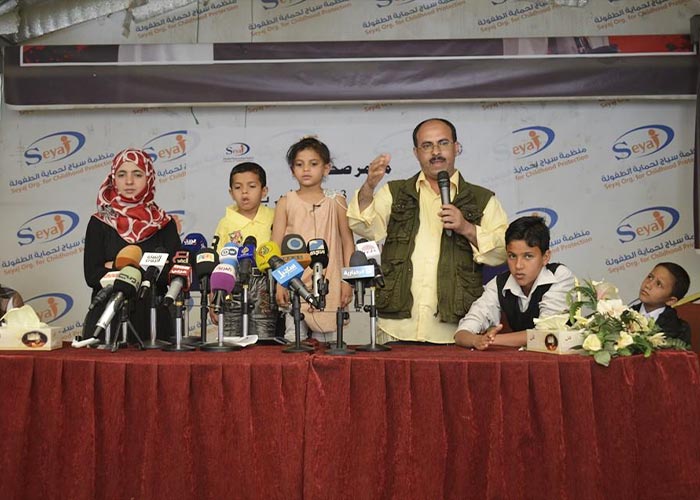Out of more than 150 abduction cases, Seyaj tracked 124 incidents involving children in 2013. The organization highlighted the prevalence of this occurrence in its report on child abduction from that year in light of the unsteady security circumstances the nation has been experiencing since 2011, as kidnapping registered the greatest numbers among infractions against children.
In Seyaj’s report launch press conference this morning, the head of the organization, Ahmed Al-Qorashi, indicated that this problem targets a very vulnerable group, denouncing the failure of concerned authorities, including the Ministry of Interior and the government, in dealing firmly with the perpetrators of these crimes. He also denounced a newly formed presidential committee for failing to mediate with kidnappers who abducted a child from Hadramout governorate in late March and took him to Shabwa governorate to put pressure on his tribe to pay off debts owed by one of its members.
Al-Qorashi pointed out that most kidnapping offenses do not get presented in court, allowing the offenders to escape.
He made the case that there are local and international childhood advocacy programs that squander sums of money on matters irrelevant to childhood protection, and highlighted the need to examine funds lost under the guise of saving youth.
He discussed the shame and stigmatizing culture that contributes to the vast underreporting of female kidnappings despite their prevalence. Several victims’ families killed them on purpose, yet no legal action was taken against those responsible. He cited the case of M.S.S., a 12-year-old girl who was saved in 2011, only to be murdered by her family in Al-Dhale Governorate with a machine gun.
Al-Qorashi called on the families of the child victims to report the kidnapping of their children and for the security services to play their required role in curbing this phenomenon, pointing out that one of the kidnappers was recently sentenced to twenty years in prison.
He also emphasized the need for coordination with the Saudi government to reduce cases of smuggling of kidnapped children to Saudi lands, stressing that there has been no coordination between the Yemeni and Saudi sides until now, even though kidnappings are funded by Saudi Arabia and victims are transferred to Saudi lands, mostly to Saudi citizens.
The conference featured live stories of children who were kidnapped and later released.
Kidnappings often took place in the center of the capital or inside schools, for revenge, property, financial disputes, or the release of prisoners. In some cases, the perpetrators of these crimes are affiliated with the army or security units.
According to Seyaj’s research, there are primarily two criminal motivations for kidnapping children. The first is to conduct crimes for personal gain, as was the case in the Taiz rape and murder of the little girl Maram. The second reason is exploitation and trafficking, which includes demanding money as a ransom or pressuring the parents into making concessions.
Many victims do not receive the necessary legal assistance, advocacy, media support, or psychological treatment. Hence, the largest gap for many abduction victims continues to be the advancement of justice and the rule of law.
From Bushra Al-Amiri – Seyaj – 16 April 2014

